
Project Gutenberg's The Kirk on Rutgers Farm, by Frederick Brückbauer This eBook is for the use of anyone anywhere at no cost and with almost no restrictions whatsoever. You may copy it, give it away or re-use it under the terms of the Project Gutenberg License included with this eBook or online at www.gutenberg.org Title: The Kirk on Rutgers Farm Author: Frederick Brückbauer Illustrator: Pauline Stone Release Date: May 2, 2008 [EBook #25293] Language: English Character set encoding: ISO-8859-1 *** START OF THIS PROJECT GUTENBERG EBOOK THE KIRK ON RUTGERS FARM *** Produced by David Garcia and The Online Distributed Proofreading Team at http://www.pgdp.net

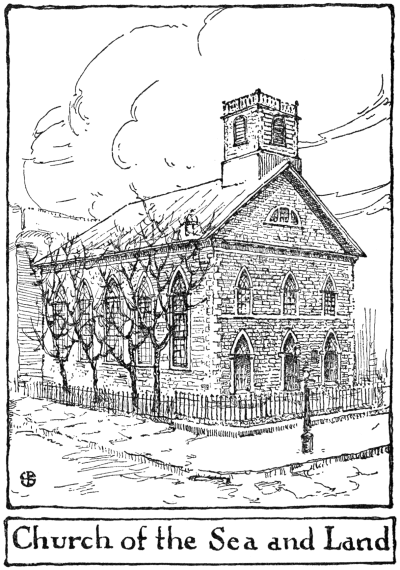
NEW YORK
Fleming H Revell Company
1919
To the
Men and Women
who gave
that the old church
might remain at
Market and Henry Streets
Contents | ||
|
Transcriber's Note: The original of this work did not include
a table of contents. | ||
It is evident that the preparation of this volume has been a labor of love.
Of the sanctuary which, for one hundred years, has stood on the corner of Market and Henry Streets, the author, like many others who have put their lives into it, might well say:
"Thy saints take pleasure in her stones,
Her very dust to them is dear."
The story of "The Kirk on Rutgers Farm" is one of pathetic interest. In its first half-century it sheltered a worshipping congregation of staid Knickerbocker type, which, tho blest with a ministry of extraordinary ability and spiritual power, succumbed to its unfriendly environment and perished.
In its second half-century it became the home of a flock of God, poor in this world's goods, but rich in faith, to whom the environment even when changing from bad to worse, was a challenge to faith and valiant service. Those of us who in our unwisdom [6] said a generation ago that it ought to die judged after the outward appearance. Those who protested that it must not die, took counsel with the spirit that animated them, saw the invisible and against hope believed in hope.
Not the least impressive pages of this book are the pages which record the names of ministers and other toilers for Christ, who in this field of heroic achievement have lived to serve or have died in service.
The author has very skilfully concealed his personal connection with the history of which he might justly say: "Magna pars fui." But for his wise and winsome leadership the chronicle would have closed a quarter of a century ago.
By putting in form and preserving the memories which cluster about the Church of the Sea and Land, he is performing a real service to the Christian community and earning the gratitude of fellow-laborers to whom it has been a shrine of their heart's devotion.
George Alexander.
| The Kirk on Rutgers Farm | Frontispiece |
| Page | |
| Henry Rutgers | 12 |
| The Rutgers Mansion | 15 |
| Rutgers Tablet | 17 |
| Nathan Hale Statue | 19 |
| First Presidential Mansion | 20 |
| Tablet in Church Vestibule | 22 |
| Philip Milledoler | 23 |
| North Dutch Church | 24 |
| Isaac Ferris | 28 |
| Organ | 29 |
| Old Lecture Room Pulpit | 30 |
| Theodore L. Cuyler at Market Street | 34 |
| Theodore L. Cuyler later | 35 |
| Pew | 41 |
| Bell | 46 |
| Sailors' Home | 50 |
| 52 Market Street | 51 |
| Hanson K. Corning | 52 |
| Edward Hopper | 56 |
| Communion Service | 58 |
| Christian A. Borella | 61 |
| Andrew Beattie | 68 |
| Old Sunday School Room | 69 |
| Alexander W. Sproull | 71 |
| Col. Robert G. Shaw | 72 |
| Kindergarten | 73 |
| Old Church Flag | 78 |
| John Hopkins Denison | 81 |
| Tower Study | 82 |
| 52 Henry Street | 83 |
| Fresh Air Children | 84 |
| New Church Flag | 87 |
| John Denham | 91 |
| Old 61 Henry Street | 94 |
| New 61 Henry Street | 95 |
| Staten Island House when bought | 96 |
| Staten Island House renovated | 97 |
| Kitchen for Cooking Classes | 99 |
| Pulpit | 104 |
| Back of Pulpit | 107 |
If there be one thing certain about New York it is that nothing remains unchanged. Not only do public works like the bridges change the face of things, but private activity effaces great structures to build up still greater ones. This march of progress is as relentless as a modern army, levelling all before it.
In other lands churches have been spared tho other buildings went down, but even these in New York have disappeared, whole districts being deliberately deserted because churches were no longer able to maintain themselves there financially. This is especially true of the great down-town section of Manhattan, the Old New York, in which only two churches remain that have stood unchanged for a century. Trinity church let old St. John's [10] go, and sixty churches have disappeared in forty years on the lower East Side alone. We lose much when old landmarks go, when we can not make history more vivid for our children by pointing out where the great men of another day worshipt, men of a day when other public assemblies were rare, and the church was the center that radiated influence. The old building is of value because of the living beings associated with it that were the life of the community.
New York has hardly appreciated what its great families have meant for it in the past. The members of the Rutgers family, for instance, always had a noble share in the day and generation in which they lived. Their ancestor came over in the early days from Holland, spent some time about Albany, and then came to New York, branching out till Rutgers bouweries and Rutgers breweries were found in more than one place.
A Rutgers was on the jury in the great Zenger trial that establisht the freedom of the colonial press,—"the germ of American freedom." The Rutgers were Sons of Liberty and the Rutgers farm near Golden Hill was one of their meeting places. A Rutgers was a member of the New York Provincial Congress and also of the Stamp Act Congress. Alexander Hamilton was engaged in a famous case when a Rutgers defended herself against a Tory who had taken possession of her property during the Revolution.
It was a Rutgers who drained the marshes west of the old Collect Pond and so laid the foundations for the Lispenard fortunes: a Lispenard married a fair daughter of his neighbor Rutgers. That stream still runs into the Broadway Subway at Canal Street apparently uncontrollable.
One Rutgers fell in the Battle of Long Island, and while the old father died in [12] Albany, the British revenged themselves on the younger brother by making a hospital of his fine house in New York. The owner kept on fighting for freedom during the whole Revolutionary War, distinguishing himself at White Plains.
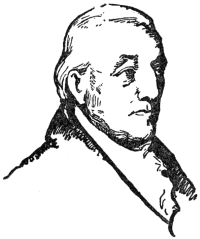
This was Henry Rutgers, in whom culminated many of the finest characteristics of a noble ancestry. His breadth of view in an age not quite so broad, is well shown in his attitude towards churches and schools. When he decided to open up his farm in the Seventh Ward for building purposes he gave land at Oliver and Henry Streets, at Market and Henry Streets and at Rutgers and Henry Streets for churches, and there was more for the asking, tho only the Baptists, the Dutch Reformed and the Presbyterians took advantage of the offer. The Rutgers [13] Street site became the birthplace of the Rutgers Presbyterian church, beginning May 13, 1798, in a frame building 36×64. In 1841 the present stone church was built, and in 1862, as did others, this organization moved uptown. A Mr. Briggs, who was holding the property for a Protestant denomination, finally tired of waiting and sold the building to the Roman Catholic church, in whose hands it remains.
In 1806 Rutgers gave the land for the second free school, and he succeeded Governor Clinton in 1828 as president of the Free School Society. Before that day education was not a state matter, but left to private enterprise, and the free schools then establisht were for the poor. Rutgers more than once paid salaries and other school bills out of his own pocket. He was a Regent of the University of the State of New York for twenty-four years, and a Trustee of Princeton.
Rutgers was not above mixing in with the political life of his time: he was a member of the legislature four times and took a prominent part in the election of Thomas Jefferson as President of the United States.
In 1811 he raised funds for the first Tammany Hall, then a benevolent organization.
During the War of 1812, Rutgers presided at a large mass meeting calling for the defense of New York when the port was blockaded and it seemed as if the British would attack it. He was a large contributor to the fund from which forts were hurriedly erected to keep the enemy out.
Rutgers was a member of a committee of correspondence formed in 1819 to check slavery. He lived to see the day, in 1827, when slavery was abolisht in New York State.
His services to the Dutch church and his munificence brought about a change of name of the college at New Brunswick from Queens to Rutgers College. It is true the sum given was only $5,000 and Rutgers was one of the richest men in New York. In our day when only billions seem to count we may well hark back to the days of simpler things.
For many years Henry Rutgers gave a cake and a book to every boy who called on him on New Year's Day. The children gathered about his door and he made an address "of a religious character."
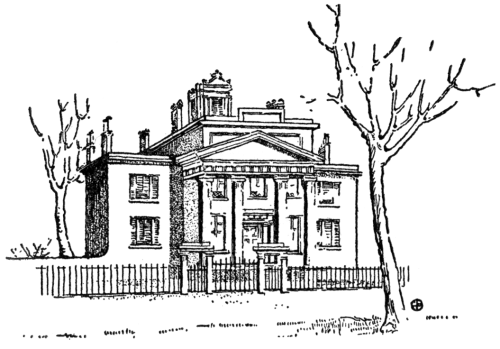
Colonel Rutgers lived in "a large, superbly furnished mansion," on Rutgers Place, "for many years a capitol of [16] fashion, where met all the leaders of the day." Here was given "the most notable reception of the time to General Washington and Colonel Willett," after the latter's return from his mission to the Creek Indians, the most powerful confederacy then on our borders. Here, also, in 1824, Lafayette was entertained "like a prince," so the great Frenchman said.
The house was built in 1755 by the Colonel's father, with brick brought from Holland. It stood on Monroe Street till 1865. But it was none too fine for the owner to give his fences for firewood one hard winter when fuel was scarce and trees in the streets were cut down to burn. Next summer the Rutgers orchard was said to have been safer than if the fence had been there.
"The well-beloved citizen" died February 17, 1830, in the mansion in which he had lived nearly eighty years. On February 28, a great memorial service was [17] held in the Market Street church. Dr. McMurray, the pastor, whose tablet is opposite that of Rutgers in the church, preached the sermon, which was printed later, speaking of his "unimpeachable moral character, his uniform consistency," and saying that there was "scarcely a benevolent object or humane institution which he had not liberally assisted." Colonel Rutgers spent one-fourth of his income in charity, many of his benevolences being personal, gifts not only of money, but advice and sympathy.
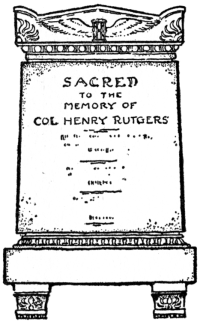
Rutgers was a bachelor and on his death the bulk of his estate, over $900,000, went to the grandson of his sister Catherine, William B. Crosby. "Uncle Rutgers" had virtually adopted the boy when early left an orphan. Among the provisions of the Rutgers will was one that bespoke [18] the testator: Hannah, a superannuated negress, was to be supported by the estate for the rest of her life. This while slavery was still legal in 1823.
William B. Crosby was a colonel in the War of 1812. He died March 18, 1865. A son of his was Howard Crosby, more than a generation ago one of the best-known preachers of New York, a man great physically and spiritually. He was moderator of the Presbyterian General Assembly and one of the revisers of the Bible. He died in 1891. Another Crosby was in the State Legislature.
The direct line of the Rutgers family died out, but they were intermarried with about every prominent family of the city. The daughters were more numerous than the sons and appear to have had a reputation for good looks and good works. They were the wives of rectors, bishops, postmasters, mayors, secretaries of state, judges, and so on.
On November 25, 1816, Rutgers had deeded five lots for a Dutch Reformed church.
The neighborhood in which the Market Street church was to be located was redolent with historic associations. The British provost marshal hung Nathan Hale on "an apple tree in the Rutgers orchard," the exact spot adjoining the church property. Nearby on Cherry Hill, in the Franklin House, the first President of the United States lived for a time, as did John Hancock and members of Washington's cabinet on the inauguration of the Federal Government.
In the immediate vicinity was the Walton House, referred to in parliament as so richly furnished that the colonies needed no relief from taxation.
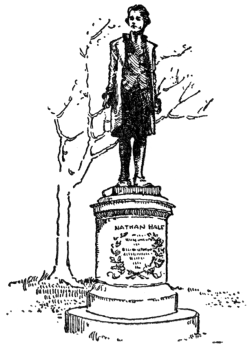
Close by the church lands, on July 27, 1790, [20] Rutgers on his own grounds paraded the militia before President Washington, Governor Clinton and visiting Indian chiefs, and thereafter he was Colonel Rutgers. Gilbert Stuart painted Washington's portrait at that time and it was a prized possession in the Rutgers mansion.
Just north on the Bowery was the old Bull's Head Tavern, "the last stop before entering town." On the evacuation of New York, Washington and his officers rested here before re-occupying the city. In connection with it the Astor fortunes were laid, and Astor was not very popular with the other butchers either, because of his business methods.
In Cherry Street a hundred years ago a sea captain and his wife made the first American flag of the present type: thirteen stripes and an ever-expanding starry field.
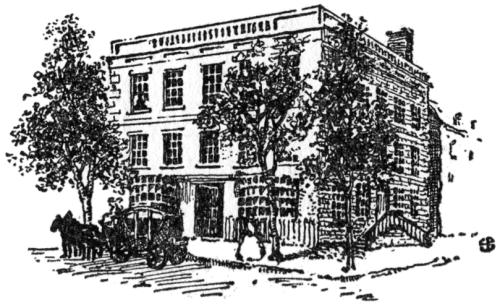
At the foot of Pike Street,—the [21] river then was nearer the church than now,—Robert Fulton built his first steamboat in 1807, and in May, 1819, just one hundred years ago, the Savannah docked in the same place, after the first steamboat trip across the ocean, made in twenty-two days.
Not quite so pleasant a memory is the fact that Market Street was the new name for George Street, of not very favorable repute, until the quiet Quakers built fine little houses there, surrounded by gardens, driving out denizens of a less sedate disposition.
A fine story is told of an old lady, who was advised not to go to the Market Street church because of the neighborhood it was in. She replied that Colonel Rutgers was going there "and where Colonel Rutgers goes any lady can go."
In 1819 wolves were still killed on the "outskirts," that being the present Gramercy Park.
After the establishment of the Franklin Street church in 1807, no further attempt was made by the Dutch church to extend its work until in 1817 the offer made by Henry Rutgers was taken up. About the same time the Houston Street and Broome Street churches were added.
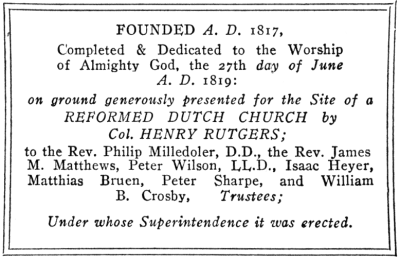
To make the Market Street building possible Rutgers gave a large sum, and he named the trustees "under whose superintendence" the building was to be erected. They were a noble group:
Rev. Philip Milledoler, D.D.; Rev. James M. Matthews, Peter Wilson, [23] LL.D.; Isaac Heyer, Matthias Bruen, Peter Sharpe and William B. Crosby.
Dr. Milledoler was one of the great men of the time. He was born in Rhinebeck, September 22, 1775, and educated in Edinburgh. He was one of the founders of the American Bible Society, and Secretary of the Board of Trustees of the Presbyterian Church. In November, 1803, he became colleague pastor of the First Collegiate church, and in April, 1809, on division by Presbytery, sole pastor of the Rutgers Presbyterian church. He remained here until 1813, when he entered the Reformed Church. He was president of Rutgers College from 1823 to 1841.
Rev. James Macfarlane Matthews was professor "in the first theological seminary of which New York could boast." It was considered Scotch Presbyterian.
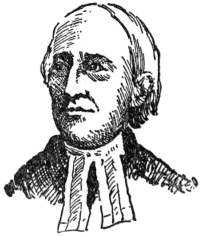
Dr. Peter Wilson was professor [24] of languages in the university, as was also Isaac Heyer.
Matthias Bruen was "one of the merchant princes of New York."
Peter Sharpe was a "whip manufacturer" and William B. Crosby is listed as "gentleman."
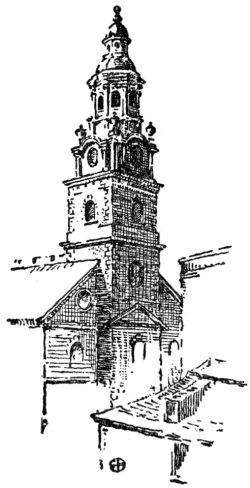
Nothing is known of the architect or builder, tho they were probably the same, as was the fashion of the time. The building was required by the deed "to be of brick or stone materials, and the whole building of a size not less than that of the Presbyterian church in Rutgers Street." A hundred years have proven the substantial character of the Market Street church. The men of that day did their work well. Whether it was a simplified copy of the North Dutch church or not is not known. It looks much like it, tho the tower is simpler [25] and the two rows of windows in the Fulton Street building become one row of great windows on Henry Street. But it has all stood the test of time. The old hand-hewn oak timbers still span the lofty ceiling, the glistening gray stone walls still stand four-square against all the winds that blow. The hand-made hinges and numbers are still on the pew doors, and the so-called slave galleries are still there, tho neither colored servants nor Sunday school children are consigned to them now. Hidden away, but still there are the hand-made laths, the shingles under the tin roof and the four-foot thick foundations.
The old tower is there, for many years untenanted, until the men came who worked and lived there, a place of seclusion in a busy time and neighborhood, and if the symbols on the rough walls have made their thoughts roam to the early Christian days the [26] telephone brings them back again into 1919.
The years have brought some changes; better heating than the first stoves,—the first coal bill was paid in February, 1832, and a new furnace cost $150 in 1848; better lighting than in 1819,—they had no gas till May, 1843,—but there have always been men who studied to maintain the quiet simplicity and beauty of the house, never more marked than in the days of its centennial.
The Reformed Protestant Dutch church in Market Street was "dedicated to the worship of Almighty God" on June 27, 1819, the Rev. Dr. Milledoler preaching the sermon. On September 8, 1819, twenty-four members united, on the 29th more were added, but "on account of the prevailing sickness" the consistory was not elected until November 10. Henry Rutgers, John Redfield and Isaac Brinkerhoff were elected elders, and [27] William B. Crosby, Elbert A. Brinkerhoff and Thomas Morrow were chosen as deacons. On November 28, 1819, they were ordained. On the day following they met at the mansion of Colonel Rutgers, when he was chosen president of the consistory. On January 2, 1821, the property was finally deeded to the consistory.
The first minister of the church was William McMurray, D.D., "who with fidelity and zeal" served from 1820 to May, 1835.
Dr. McMurray was born of Scotch-Irish parents in Washington in 1783, and graduated from Union College in 1804, studying theology under the famous J. M. Mason. He was a great worker, preached three times each Sunday, conducted catechism classes, and is said to have known nearly everyone in the Seventh Ward. He contracted typhoid fever, lingered for a while and died September 24, 1835.
A Sunday school was started in 1821.
In 1834 the elders and deacons are recorded as being: Crosby, Hoxie, Andrews, Doig, Moore, Herrick, Cisco, Montanye, Conover and McCullough, all famous names. Hoxie and Cisco were wholesale clothing merchants in Cherry Street then the center for that trade.
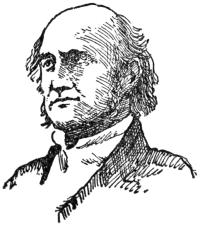
In August, 1836, Dr. McMurray was succeeded by Isaac Ferris. He was a New Yorker, entered Columbia when only fourteen years old, graduated with first honors and fought in the War of 1812 with his father. The Sunday school reported 213 pupils at the time of his coming, which soon increased, for Dr. Ferris paid special attention to the school. He was president of the New York Sunday School Union and first president of the Foreign Mission Board of the Dutch Church. The church had 600 communicants, and was [29] described as "a fashionable church in the aristocratic Seventh Ward."
His son, Dr. John Ferris, spent much of his earlier life with his father. Dr. Isaac Ferris died June 13, 1873. He was tall, broad shouldered and of commanding presence.
In 1841 the organ was ordered and finally completed in 1844. It was built by Henry Erben, of New York, whose son became admiral in the Navy. Experts tell of the amount of lead used in the construction of its pipes. It is still pumped by hand as in the olden days. John Pye was the first man to do this. George Loder was the first organist, and P. A. Andri the first chorister.

In 1843, on the land back of the church the "Consistory Building" was erected. It was a plain brick building with a high stoop and heavy wooden shutters. The upper [30] floor was for the Sunday school and provided with circular seats for classes. In an alcove on one side and closed by glass doors was the library railed off from the rest of the school. On the main floor was the lecture room, the floor of which rose in the back. Between the stairways leading to the next floor was a platform with two heavy Greek columns and a reading desk between them. It was a bold boy who would run back there thru the dark when the "infant class" met in the room. The columns were removed in the seventies and later on the rounded stiff seats went too. Then the floor had to be leveled so that the room could be put to general use. Before that it was possible to reach most of the seats only by passing between the "leader" and the audience.
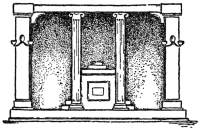
In the basement in dingy quarters in the [31] rear lived the sexton. He had the great improvement of having water brought into the house in June, 1847, by a sixty-foot hose. Six years later the hydrant was put up in the front church yard, remaining there until quite recently.
To the right and under the stoop there was a hallway, which later was changed to the "pastor's study," in which all smaller important meetings were held. It was in this little room that the session received members and for many it holds very sacred memories.
There were no pictures in the building, but later a few mottoes with Bible texts were hung about.
In early days a part of the building was rented for use as a school. The rental was only nominal. At the time of the erection of the consistory building the sidewalks around the whole property were flagged and the iron fence erected.
In 1848 the upper floor was arranged for the Sunday school at a cost of $500. About 1871 doors were cut thru to the galleries of the church from the upper floor. For more than twenty years this had been urged.
John Crosby is recorded as "paying off the church debt of $10,542" in June, 1852.
Dr. Ferris left in 1853 to become chancellor of the University of New York, succeeding his friend, Theodore Frelinghuysen. The first chancellor had been Dr. Matthews, a trustee of the church, and the successors of Dr. Ferris were Howard Crosby, John Hall and Henry M. McCracken. So of six chancellors of the university, four were vitally interested in the Market Street church.
With the coming of Theodore Cuyler a new era opened up for the old Market Street church. Two years before Dr. Cuyler had spoken at a large temperance meeting in Tripler Hall, together with General Houston, Henry Ward Beecher, Horace Mann and other celebrities. It was his first public address in a city that was to know much of him.
In 1853 Mr. Cuyler was called and installed by the South Classis of New York, November 13, 1853. He says that while walking along Henry Street Judge Hoxie said to Mr. Lyles: "If our young brother will come and work in the Market Street church we might do something yet."
Cuyler lived at Pike and Madison Streets and later in Rutgers Street. His salary was $1,500, advanced later to $2,500. The church building was painted, and in 1855 a new roof was put on at the expense of the pewholders.
Opposite the church on the northeast corner was a large and select private school. At 11 Market Street later was a smaller one, headed by a German patriot, whose son-in-law was one of the great generals during the Rebellion.
In his address in the church at the Eightieth Anniversary, Dr. Cuyler called it "fighting the adversary of souls and geography," for even in Dr. Ferris's time there were indications of waning strength because of "the continued emigration of the more substantial class of church members from the down-town districts of the city uptown."
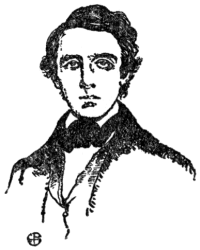
But the indefatigable Cuyler postponed the evil day, and for seven years [35] of intensest activity he remained in Market Street.
To quote Dr. Cuyler: "I looked around me and saw there were a good many substantial families that could support a church and East Broadway swarmed with young men."
"Here was the lord of the manor, the nephew of Colonel Rutgers, Wm. B. Crosby. What a devoted Christian he was. His good old gray head moved up to the pew every Sunday, rain or shine. There was a deacons' pew, and in the center sat the best-known man in New York, Judge Joseph Hoxie. When we said the creed and nobody joined he shouted it, and in song his voice was heard above the choir. There sat Jacob Westervelt, the mayor of New York, and he boasted that he was the only member of the Dutch Church who could read a Dutch Bible."
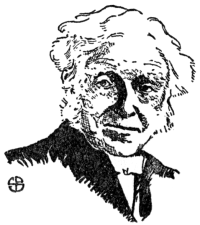
The galleries were packed with young men. One, a young Irish boy, Robert McBurney, became the great secretary of the Young Men's Christian Association. Charles Briggs was another young member, and around him later raged the bitterest theological controversy of the century.
During the summer of 1854 the service was changed to 4 P. M., 7:30 being resumed in September.
In 1855 the seats in the gallery were changed from four rows to three rows, and the infant school was held in the "scholars' gallery" of the church. The low seats are still in the second gallery.
A stove was put in, too, as the heating was not satisfactory.
In 1855, A. D. Stowell came as Bible class teacher at a salary of $12 per month.
Dr. Cuyler rightly referred to it as a busy old hive, for from Market Street [37] church emanated some of the greatest religious movements of the century.
Howard Crosby, son of William B. Crosby, and brought up in the Market Street church, was the first president of the Young Men's Christian Association. Cuyler became interested in it the second year of its existence in New York, and during his long lifetime he never ceased to work for it. But if the church had done nought else than bring Robert McBurney to the Association it would have been amply repaid. The master spirit in the Association for thirty years McBurney's name is written in golden letters in the city's history. Morris K. Jesup and William E. Dodge, life-long friends of the church, were early Association supporters.
A work typical of Market Street church was the Fulton Street prayer-meeting, started by Jeremiah C. Lamphier, who sang in the church choir. Dr. [38] Cuyler credits this with being the first move in the tremendous revival that from 1856 to 1858 swayed the city, and went on to other cities, gathering momentum. Cuyler says: "In three or four weeks the revival so absorbed the city that business men crowded into the churches from 12 to 3 each day, and when Horace Greeley was asked to start a new philanthropic enterprise he said: 'The city is so absorbed with this revival that it has no time for anything else.'"
Market Street church gathered in 150 new members, and 1859 was one of the glorious ones in the history of the church.
Mr. Lamphier died December 26, 1898.
In the Temperance cause, Dr. Cuyler was also a ceaseless worker. From 1851 to 1857 he was in close alliance with Neal Dow, then at the height of his fame as a prohibition advocate.
Another organization that had an earnest supporter in Dr. Cuyler was the Christian Endeavor Society, tho Cuyler gives all the credit for its fatherhood to Rev. F. E. Clarke.
In a day when such things were not common Market Street church got deeply into matters civic. "The most hideous sink of iniquity and loathsome degradation was in the then famous Five Points," Baxter, Worth, Mulberry, Park Streets, not far from the church. An old building, honeycombed with vaults and secret passages, called the Old Brewery, was the center of a locality that boldly flouted the police. Indeed, for years the Old Brewery was a harbor of refuge for any criminal, for the law never reached him there, nor were the Five Points ever a safe place to walk thru. At night no one dared be seen there. For some years the Five Points had played a physical part in the elections, and many a riot had its inception there.
Then the city put thru Worth Street, formerly known as Anthony Street, after a Rutgers, and the Old Brewery Mission was establisht there. Thru Mrs. Pease, a member of the Market Street church, whose husband was the brave projector of the Five Points House of Industry, the church became interested in improving conditions. When Mr. Pease went south, his place was taken by Benjamin R. Barlow, one of the Market Street elders.
In his autobiography, Dr. Cuyler tells how he "used to make nocturnal explorations of some of those satanic quarters" to keep public interest awake in the mission work at the Five Points. New Yorkers who remember the House of Industry of thirty years ago and who now look at Mulberry Bend Park may well thank the old Market Street church that the Cow Bay, Bandit's Roost, the Old Brewery and Cut Throat Alley are [41] things of the past, and that the Five Points are known to this later day only as a name. No second Charles Dickens will cross the ocean to tell us that "all that is loathsome, drooping and decayed is here."
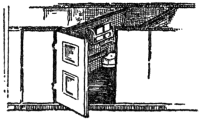
Few men have been in touch with so many public movements as Dr. Cuyler. He was the personal friend of statesmen, churchmen, professors, lecturers, teachers, philanthropists, diplomats, poets and presidents. And as was the minister so were the people of the Market Street church: forward in every movement for the betterment of mankind, the coming of the kingdom. Some of the best families of New York were connected there, and as fathers bought pews for the sons when they married it was a family church. These names are frequent: Duryee, Crosby, Mersereau, Brinkerhoff, Poillon, Zophar Mills, Ludlam, Suydam, Westervelt, Waydell, [42] Chittenden, Bartlett, McKee, Purdy and a host of others.
Small wonder that from among men like these great institutions should come, that the Park Bank and the Nassau Bank should be founded by Market Street church men. The annual pew rents were $5,000, then a large sum.
Perhaps it was their very farsightedness that made the people of the church think of moving uptown. The "brownstone front" was drawing people northward, and Dr. Cuyler started a movement "to erect a new edifice on Murray Hill, and to retain the old building in Market Street as an auxiliary mission chapel." Subscriptions were secured, William E. Dodge heading the list. But the new site at Park Avenue and Thirty-fifth Street did not find favor, and many were opposed to the whole project, so when in 1860 the consistory was to vote [43] the first payment, the whole enterprise failed by one vote.
Dr. Cuyler said he would thank the good old man who cast that vote—Meade was his name—if he ever met him in the other world. He resigned from Market Street church, his ministry ending April 7, 1860, and accepted a call from the little Lafayette Avenue Presbyterian Church in Brooklyn. His friend, Henry Ward Beecher, did not see how he could get a congregation there, but after many years of ever-increasing usefulness Mr. Beecher lived to say to Dr. Cuyler: "You are now in the center, and I am out on the circumference."
It was strange that a man of the forceful type of Cuyler should leave a church because it would not move away, and that thirty years later he should preach in it, rejoicing in its continuing prosperity. Strange, too, that Cuyler left the Dutch Church for the Presbyterian, and [44] that the old building "changed its faith" in like manner.
Rev. Chauncey D. Murray was the next pastor of the Market Street church, the classis installing him March 10, 1861, and he was succeeded in 1863 by Rev. Jacob C. Dutcher. William B. Crosby, of beloved memory, came forward with very liberal contributions to sustain the church, but the depletion went on. In Mr. Murray's time another attempt to move uptown had failed.
In December, 1859, the courts had already given permission for a sale, but on condition that another church be built uptown with the proceeds. This having failed, under a revised order of the court the building was deeded to Hanson K. Corning in 1866, another congregation having meanwhile inaugurated services there.
The old consistory lived on till June 2, 1869, when it held its last meeting at [45] the home of R. R. Crosby, in Twenty-second Street. A committee had secured the necessary legal modifications so that the temporalities could be disposed of. The distribution was as follows:
To St. Paul's Reformed church on Twenty-first Street, $15,000; $8,000 to the Prospect Hill Reformed church on Eighty-fifth Street, and about $18,000 to the Northwest Reformed church on Twenty-third Street. A $500 United States bond was given by William B. Crosby to the Sunday school of the Twenty-first Street church. The baptismal font was presented to St. Paul's church, the splendid communion service to the Prospect Hill church. All these churches have past out of existence. The organ was presented to the Church of the Sea and Land; "the property right in the Henry Rutgers tablet was given to R. R. Crosby; the McMurray tablet to Henry Rutgers McMurray. A vault [46] in Twenty-second Street was given to the Prospect Hill church. The bell, now loaned to the Church of the Sea and Land, was given in a revisionary right to the consistory of the Collegiate church, in case it ever ceases to ring for a Protestant church." It still rings undisturbed, tho it has not in the memory of man swung on its wheel. Only recently has it been given back one of its earliest powers: it is to ring the alarum if all modern means fail. It was cast in Troy in 1847, and the committee (Crosby, Conover and Lyles) spent $365.14 for it. The congregation thought too much of it in 1848 to allow its use by Engine Company 42 for fire alarms. The books of the Market Street church were left to the Collegiate church and are now at New Brunswick.
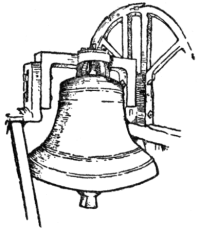
All this having been done, the president of the consistory, Mahlon T. Hewitt, handed out [47] the remaining letters of dismissal to D. W. Woodford, Robert R. Crosby, William Lain, Dr. Veranus Morse, John Van Flick, Henry Taylor and Albert I. Lyon, and made a formal closing address in which he offered "a sincere prayer that its old walls may still stand, and that it may continue to be the birthplace of souls into the kingdom of Christ." The prayer has been answered.
Thus ended the Protestant Reformed Dutch church in Market Street after just fifty years.
While the Market Street Reformed Church was fighting its last fight, a little congregation had come to life in the parlor of a sailor's boarding house. It was intended chiefly for "seamen and others," the "others" referring mostly to those who no longer sailed the seas. The first meeting was held June 7, 1864. Those were the days of sailing vessels; the New York of the thirties had been the ship building center of the world, especially from Pike Street up. At every pier sail boats were moored, coming from all over the world, and as they dismist their crews on arrival it left the men on shore unoccupied until their meager wages were gone, when they were crimped for another voyage. Low [50] dance halls and worse were all along the river front and the sailor was their prey. The American Seamen's Friend Society sprang into being to improve the situation, and erected a fine building in Cherry Street, to give the men surroundings that were clean physically and spiritually. With the present federal laws for the protection of seamen the condition in the sixties can hardly be appreciated.
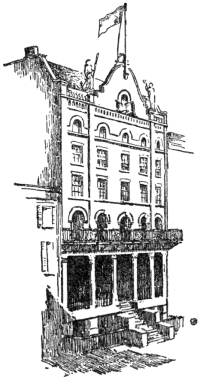
Where Fulton had built his first steamboat fifty years before huge yellow dry-docks now rose. Additional land had been gained so that Water, Front and South Streets grew out of the river. All along the river front sailing vessels pushed their bowsprits and gilded figureheads far over the streets almost into the windows of the sail-lofts that were numerous along South Street.
For these men then the [51] Presbytery of New York on December 29, 1864, at 52 Market Street, organized the Presbyterian Church of the Sea and Land, with thirty-two members. Dr. Phillips, Rev. Rice and Rev. A. E. Campbell, and Elders A. B. Conger and A. B. Belknapp, were Presbytery's Committee, and John Simmons and John H. Cassidy were the first elders.
Rev. Alexander McGlashan was installed as pastor, February 2, 1865, serving for a little more than a year. Ill health was the reason for his leaving. He died in 1867. The deacons were Henry H. Smith and Henry Harrison; also Philip Halle, who served for only a short time.
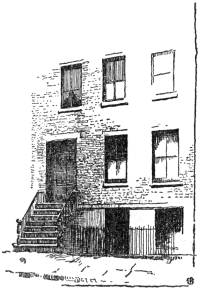
On December 26, 1865, the following trustees were chosen: John H. Cassidy, John Simmons, Henry H. Smith, Henry Harrison, David Robb, John Neal, and Jas. [52] McGlashan. At this time there were 74 members and the year's receipts were $2,372.67.
The Sunday school was organized January 1, 1865, 25 being present, soon growing to 80. It had a library of 400 volumes, costing $122.25. John H. Cassidy was superintendent and T. M. May secretary. Wm. McCracken was president of the Temperance Meeting and Joseph W. Cassidy president of the Band of Hope.
But the man that was most prominent at this time in the church's history is never mentioned in the official records.
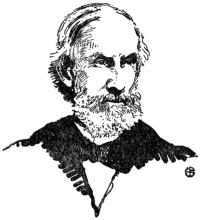
Hanson K. Corning was a shipping merchant, who knew from his own business connections the helpless condition of seamen when in port.
He was born in 1810 in Hartford. The Cornings conducted a large South American [53] import business, with offices at 74 South Street. Three generations were active in it.
Hanson K. Corning lived in Brazil for a few years, paying special attention to the rubber business and also acting as United States Consul.
On his return to the United States he became a member of the firm, and the business prospered greatly. Altho Mr. Corning in later life became an invalid, he went to his South Street office until 1860. Thereafter he gave his time completely to religious and philanthropic work.
When, in the early sixties, the decline of the Market Street church became evident, Mr. Corning conceived the idea of making it a sailors' church.
He entered into negotiations with the consistory and on May 1, 1866, he became owner of the property, paying $36,500 for it. The Church of the Sea and Land moved into the building about this time. [54] The congregation occupied the premises rent free, and in October, 1868, the property was transferred to the Presbytery of New York, to insure greater permanence. Mr. Corning sold it for $25,000, which meant a gift of some $10,000 from him, the church itself giving about $1,500. James Lenox contributed $1,000.
The deed was a peculiar one, making the Church of the Sea and Land a third party, and giving it the right of occupancy as long as it was in ecclesiastical connection with the Presbytery, "or until in the judgment and by vote of three-fourths of the members present at any regular meeting of the Presbytery it shall be decided to be no longer expedient to continue or sustain religious services or missionary work in that church or locality."
It was also stated in the deed that all seats should be free, whereas in the Dutch church the pews were private property except that one-tenth of the [55] pews were to "be free forever for the use of the poor and of strangers," and such pews were marked on the doors as free.
This is why the new church boldly painted "seats free" over the doorway.
Mr. Corning was a member of the Brick Presbyterian church, to which he gave considerable sums. He contributed liberally to many objects, but not indiscriminately, and the mission fields in Brazil, the American Bible Society and many other organizations were stronger for his munificence and wise counsel. Mr. Corning died April 22, 1878. A gift of Mr. Corning that the church still cherishes is its pulpit Bible.
Mr. Corning's interest in the church that practically was founded by him has never ceased, for after his death his daughter and son again became interested, and the third generation is still represented in the officers of the church and among its givers.
Rev. S. F. Farmer supplied the pulpit for a little while till John Lyle was installed June 25, 1867. Next January the session met almost continuously for the reception of members. The records show that in 1867 and 1868 133 members were received after examination and 80 by letter.
In November, 1868, Mr. Lyle was deposed by Presbytery. He died in 1881.
Edward Hopper came in 1868 and on June 29, 1869, he was installed as pastor.
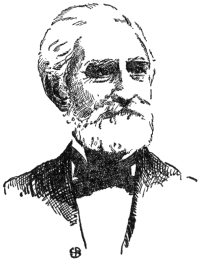
Mr. Hopper was born on February 17, 1816, graduating from Union Seminary in 1842. He was pastor at Greenville, N. Y., eight years, at Sag Harbor, L. I., eleven years. After a short time at Plainfield, N. J., he accepted the call to New York. In 1871 Lafayette College conferred the degree of Doctor of Divinity on him.
Dr. Hopper wrote a number of poems that were [57] publisht in three volumes. During his Sea and Land ministry he was brought in contact with seamen and this finds expression in his later works taking character from life on the sea. Many of his verses have found place in Christian hymnology, notably such a lyric as "Jesus, Savior, pilot me over life's tempestuous sea," with that sweet verse "as a mother stills her child Thou canst hush the ocean wild." Another hymn was "Wrecked and struggling in mid ocean, clinging to a broken spar."
During the Civil War Dr. Hopper had written some stirring verses, one on The Old Flag being especially noted.
He was of fine literary taste and culture, proud of his Knickerbocker ancestry. Physically as well as intellectually he was every inch a man, with his bright eye, fine face and, in later years, a snow-white beard. Even in his three score years and ten a decline was hardly [58] perceptible until in the fall of 1887 the companion of his lifetime and partner of his literary pursuits was taken from him.
On April 22, 1888, his text was: "Watch, therefore, for ye know neither the day nor the hour wherein the Son of man cometh." Next day at noon his niece found him in his study chair, his pencil dropt from his lifeless hand. Before him was a poem: "Heaven."
He left to his nieces a rather large estate, consisting principally of railroad stocks, with legacies for home and foreign missions. His investments had been made on the advice of his friend, John Taylor Johnson, the railroad president, who presented to the church the communion service that was in use for over fifty years.
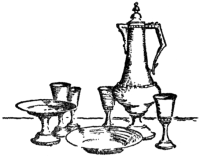
In Dr. Hopper's time the work of the church for seamen reached its highest development, and that was due to Christian A. Borella. He was a missionary of the American Seamen's Friend Society for twenty-one years, stationed at the Sailors' Home in Cherry Street, and surely a man of God. Borella never came to church or prayer-meeting alone: he always had men in tow.
There was an upper room at the Sailors' Home that meant much to many men, and there Borella did a work that resulted in great acquisitions to the church. It is true that many "going down to the sea in ships" were never heard of again, and years afterwards nearly 400 names of seamen were at one [60] time removed from the roll by the session. But again and again word came from all parts of the earth and in many languages from men that called the church blessed. It was only an exemplification of the wide scope of Sea and Land when a generation later one of its ministers chanced across one of these men in Western Australia.
A feature of the prayer-meeting in those days was the reading of these seamen's letters, giving account of themselves to Borella. They always stirred the man, who would add words of Christian admonition that lacked nothing in definiteness.
He was the right hand of Dr. Hopper, re-wrote records and generally made himself useful.
But in his olden days he became restless and as no mission board would take a man of sixty-four years he went, after Dr. Hopper's death, to Africa at his own [61] expense. He soon attached himself to Bishop William Taylor and with his master's certificate ran the missionary boat Anne Taylor on the Congo.
Bishop Taylor says of his end: "One Sunday morning we walked together to a preaching service at Vivi top. Captain Borella was suddenly taken ill and on my return there Monday morning was very low with fever. On August 12, 1891, he fell asleep in Jesus, and we buried him under a huge baobab tree at Vivi top."
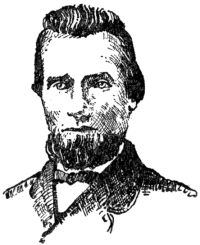
Physically he was stockily built, well knit and evidently a strong man, always neat, but exceedingly plain in dress. He was born in Southern Denmark, of Spanish ancestry. His modest fortune he had made in California in '49, and his conversion was under Father Taylor when Borella came under his influence in Boston. It was Father Taylor of whom Walt Whitman said that he was "the one [62] essentially perfect orator" he had ever heard.
After several voyages Borella became "cold and a backslider," and an eye disease nearly blinded him. "The Lord cured my blindness, physical and spiritual, and I promist him then that I would serve him the rest of my life," and he did it with the virility and sternness of an Old Testament prophet.
Borella was succeeded by Captain William Dollar, a dear old saint, who was stationed at the Sailors' Home for twelve years.
The church's work in these earlier days was simple enough, prayer-meeting Thursdays, then Wednesdays, and temperance meeting under McClellan and Campbell on Friday. But on Sunday, besides the two long church services there was Sunday school, morning and afternoon, and young people's meeting preceding the evening service.
When the sailing vessels were still along South Street, meetings were held on ships as opportunity offered.
In 1882 the interior of the church was papered and painted by Elder B. A. Carlan at a cost of less than $1,000. New cushions, carpets, etc., brought the total up to $1,564.
The one annual event was the Sunday school excursion, when all went on board a barge, which was towed by a tug to a grove on the sound or on the Hudson. Dancing was tabooed, but a "melodeon" was carted to the dock and hymns were sung. The tickets were fifty cents for adults, but Sunday school children were free. Robert S. Taylor, veteran secretary, was chief ticket seller, not only on the dock that morning, but in Wall Street for weeks before. The president of the Temperance Society once or twice put in an excursion just ahead of that of the Sunday school, and there was dancing. [64] But this was generally disapproved.
Miss Fanny Crosby often came to the Primary in those days and many of her hymns were first sung there. Mr. Blackwood, her attendant, married Miss Devlin, the teacher of the class.
In those days Market and Henry Streets had many two-story and attic houses and in almost every one of those about the church people lived who went there.
Teachers whose names stand out about this time were: Hans Norsk, James Brown, Thomas Miller, William Stevenson, Evan Price, James Smith, William Gibson, Robert Pierce, Dr. Theodore A. Vanduzee, Jesse Povey, Mrs. B. C. Lefler, Mrs. S. M. Nelson.
The excursions gave rise to a committee of young people who started to provide amusements other than dancing: swings, songs, and so on. There came also an "executive committee" that asked [65] many questions, and Dr. Hopper, in a courteous and kindly way answered them in full: that was the first report made to the congregation. Till then the annual meeting had consisted of reading the names of the subscribers who had contributed by means of the monthly envelopes, and the amounts they gave.
But Charles J. Lemaire could not understand why this excursion amusement committee should not become a permanent organization with literary purposes. Thus began the Lylian Association that for twenty years was a mainstay of the church and in its days of dire necessity was a vital factor. From it came the young men that in later years were trustees, and it was the opening wedge that was to transform the whole church work.
When two of the young men came to the trustees for permission for a literary society to meet weekly, it was questioned [66] whether anything but religious meetings might be held in the building. But after serious reflection the two were made personally responsible for good order, provided always meetings were opened and closed with prayer.
In a day when the young people had no outlet whatever for their active spirits the Lylian Association became a training school for the church. The debates of that day will never be forgotten, notably when the Lylians wrested the laurel wreath from the Goldeys at Clarendon Hall, and that other one, when Dr. Hopper suddenly appeared at a meeting and after an impromptu debate "showing every evidence of being well prepared," as he said, some consciences were ill at ease.
Then there was the Gossip's Journal, provoking endless parliamentary wrangles, and perhaps helping to develop later on an editor. Memorable were the [67] Young People's Conventions of 1886 and 1887, and Lylians will never forget the patriot Kromm, Spoopendyke Shreve, the poet laureate and a dozen others. The Fourth of July picnics at Pamrapo and Nyack are happy memories for many.
Like the old Market Street stoop with its fancy iron posts and rails the Lylian Association has seen its day, but it amply justified its existence.
When one Monday evening Mr. Pinkham, the church treasurer, announced to the Lylians the sudden death of Dr. Hopper, there was consternation and adjournment.
Andrew Beattie, a theological student, had been called before this as co-pastor. He was installed as pastor May 29, 1888, having been persuaded to give up his intention of going to the foreign field. Mr. Beattie lived down town, and his bachelor apartments on East Broadway were a [68] gathering place for the young men, many of whom were in his Sunday school class. He with others worked out the system of quarterly written examination and grading that since 1888 have been uninterruptedly in force in the Sunday school, long before other schools thought of such things.
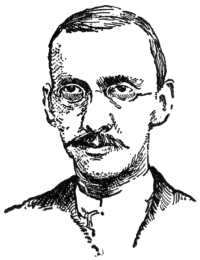
The school was flourishing with many young people as officers and teachers, all the activities of the church being centered on its nursery. The records were systematized, and articles in the church papers printed on the system, electric bells were installed, fire drills were inaugurated, discipline was rigid, visiting by teachers and districts was carefully regulated, the library given attention. Mr. Beattie returned to his first love, resigning after eight months to go to the foreign mission field. After years of greatest usefulness in Canton, China, [69] his health necessitated his return. Dr. Beattie is with his family in California, where he is in charge of a Presbyterian orphanage.
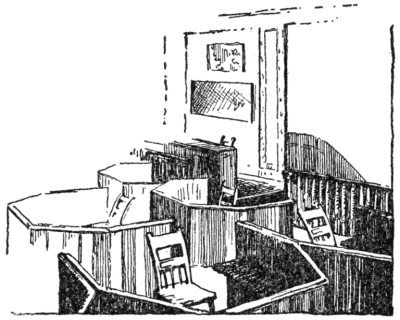
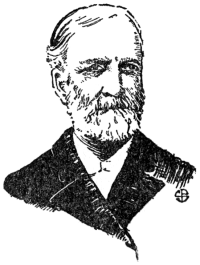
Reverend Alexander W. Sproull followed Mr. Beattie on January 5, 1890, serving for three years. He had been Synodical Missionary in Florida. After leaving Sea and Land he was incapacitated for further active service. He died December 13, 1912.
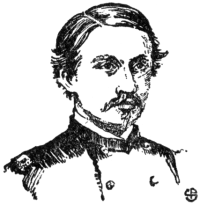
Another breach was made in the conservatism of the old church when one of the young trustees proposed to let the New York Kindergarten Association use the room rent free for a kindergarten, then new in the neighborhood. The older, wiser heads were gravely shaken at this remarkable innovation, but it [72] came on March 31, 1892, and with it the beloved Anna E. Crawford as teacher. The fairy godmother who maintained it was Mrs. Francis G. Shaw, giving the kindergarten the name of her son, Robert Gould Shaw. It was a happy combination this, and the little boys became strong men in the memory of the young Colonel who gave his life at Fort Wagner at the head of the First Colored Regiment. They buried him disdainfully "with his niggers," but Robert Gould Shaw lived again in the lives of little boys trained to sacrifice at Sea and Land. Nor will the Colonel's sister be forgotten: Mrs. Charles Russell Lowell, who gave her young husband in the same cause and thereafter lived a life that merited William Rhinelander Stewart calling her "one of the most useful and remarkable women of the Nineteenth Century." Her spirit of service was renewed in the little girls of the Shaw Kindergarten. [73] The beautiful bas relief by St. Gaudens on Boston Common is less of a memorial than the kindergarten in Henry Street.
Mrs. Shaw died December 29, 1902, having supported the kindergarten for eleven years.
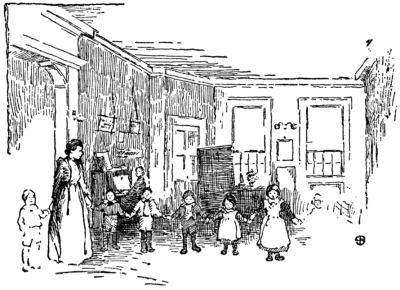
Another departure was an open air meeting establisht by Mr. Sproull, gathering at the church door Sunday afternoons. First things are hard things.
But a storm was brewing. Uptown churches needed money, their pastors were influential in the denomination and it seemed to many good business to dispose of the Market Street church.
So, on March 13, 1893, Presbytery ordered the church sold, declaring, to comply with the Corning deed, that "missionary work in the church or in that locality was no longer expedient." The church pointed out that 29 of the 57 churches in New York Presbytery had received less members during the preceding year, 16 churches had fewer members, 14 churches raised less money, and that 6 churches made a worse showing than Sea and Land in every single item reported on. There were then only 4 Protestant churches for 60,000 people. The battle was on, and the bitterness of the Briggs trial had not yet subsided,—the same Briggs who as a young man belonged to Market Street church.
Mr. Sproull's small salary allowance was discontinued and he was forced to resign, July 1, 1893. Then came hard times, no friends, no minister, no funds. [75] But when the tale of bricks was doubled Moses came.
It was in the shape of a legacy from Borella. That saint on his death in Africa had left his estate in America to the Church of the Sea and Land and the American Seamen's Friend Society jointly. If Borella had lived he could not have arranged it for a better time.
Meanwhile by an accident the press of the city gained the whole story from the church's viewpoint, and thereafter all the news reports were tinged favorably to the down-town church that insisted on living. There were illustrated articles on the church's history, caustic editorial comments, letters from correspondents, and everybody talked about the church. The ash barrels and the church doors had bills posted on them announcing that the Church of the Sea and Land would be sold at auction on April 19, 1893. The property, however, was withdrawn when [76] the best offer was $15,000 short of what was expected. There was a lull.
In the spring of 1894 it became necessary to devise some means of helping the New York Presbyterian Church on 127th Street, which was buried by mortgages amounting to $118,000, about to be foreclosed. Sea and Land was to furnish part of this and a mortgage was suggested. The church trustees opposed this successfully, altho at first it was supposed their consent was not required. Without the knowledge of the church a sale was then again ordered January 18, 1895.
Preceding this, beginning October 1, 1894, the church had "affiliated" with the Madison Square Presbyterian church. As Presbytery had formally approved this the Madison Square church remonstrated vigorously thru Dr. Parkhurst, but feeling that Presbytery's action could not be relied on the Madison Square [77] church withdrew at the expiration of its one year of affiliation.
Committees of prominent clergymen visited the church and were "warmly" welcomed. It was suggested that Sea and Land unite with other churches, but it is a singular fact that, as when the Reformed church disbanded, so now, not a single church is in existence that was then mentioned for a refuge. A case in point is the Allen Street Presbyterian church. They had sold their building near Grand Street and for a time worshipt in the Market Street church. But in spite of earnest solicitation they erected an unfortunate structure in an unfortunate location in Forsyth Street. After a short existence there they united with the Fourteenth Street church, and that church is no more!
Even the strong Madison Square church no longer preserves its identity.
Meanwhile work went on, at first in desultory fashion, two or three times the young men had to conduct services. But thru it all Dr. A. F. Schauffler, of the New York City Mission Society, was the church's consistent friend. His order to the city missionaries at the church to stay until the doors were shut was the one heartening feature of a time when the officers ordered the blue church flag raised and "no one from Sea and Land will ever take it down."
The Women's Branch always ably seconded these efforts under Mrs. Lucy S. Bainbridge and later Miss Edith N. White.
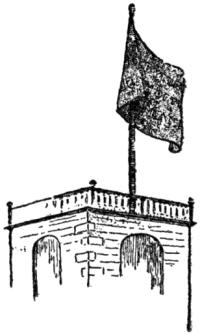
Instead of slowly dying out the work of the church gained momentum from day to day: Lodging house meetings, Sunday afternoon teas, free concerts, addresses by Gompers, McGlynn, Henry George, Parkhurst and others, sermons "against thugs in politics," and so on.
A permanent accomplishment of the nine months' intense régime of Alexander F. Irvine was the starting of The Sea and Land Monthly, the first number of which appeared in October, 1893. With characteristic impetuosity Mr. Irvine launched it, and it has been afloat for more than a quarter century.
The Monthly has been a great storehouse: not only did it give from month to month the happenings at the church, but it brought to later generations an appreciation of the goodly heritage of years that had gone before.
The vital events in the congregation's history were recorded, but so was the personal history of its people. The coming of little messengers to the homes, their baptism, their reception into the church, their marriage, their death. Then began another cycle like unto the first.
And the Monthly kept alive the interest of many a Sea and Lander who was [80] adrift. It gave account of its stewardship to the friends of the church who supported its work. Few churches ever publish with such detail the annual reports as does Sea and Land.
Many are the kind words from near and far that have been said about the Sea and Land Monthly.
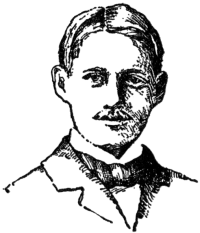
But if the Madison Square church withdrew officially it left behind more than the old church ever expected. It was a young man who, in October, 1894, reported to the Sunday school superintendent as coming from Madison Square. He was John Hopkins Denison, a grandson of Mark Hopkins, of fine New England stock. He had come to New York to become Dr. Parkhurst's assistant when he was making war on Tammany. Those were the days of the City Vigilance League, when unsavory revelations were necessary to effect a change in city government. There was a meeting which crowded the old church to the second galleries when Dr. Parkhurst [82] spoke. It was a noble battle and not without its dangers.
So when the Madison Square church went, Mr. Denison staid, and he was a prodigious worker. The quarters in the tower were enlarged for there were many visitors who bunked there.
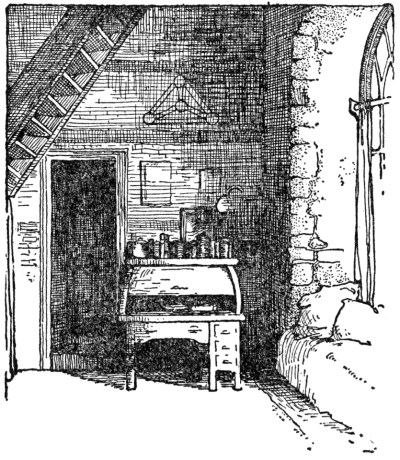
Mr. Denison set out to prove the right of the church to existence and he did it. He did more: he brought no end of friends that remained to the church. The thought of Cuyler to establish a mission, [83] of Parkhurst to affiliate the church with a stronger one, was developed under Denison into an organization amply supported by the whole church, working out by itself its own local problems. It was no longer a self-evident proposition that a church not able to support itself must go.
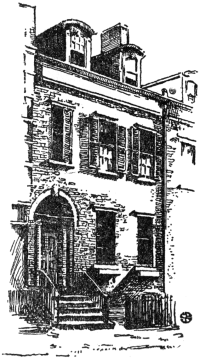
One of the early steps was the establishment of a church house at 52 Henry Street. Mr. Denison said: "It was not an institution—it was not even a settlement; it was simply a house where people lived. The time is gone by for men and women to come down as outsiders and pry into the homes of poverty and sin, and [84] then return to their own life far away. One must live in a community, one must be a neighbor."
Mr. John Crosby Brown was the munificent friend who made the house possible, Miss Mae M. Brown being a deeply interested resident there. Mrs. Rockwell was in charge, then Miss Eleanor J. Crawford. It was the center for all social activities, tastefully fitted up, the ladies working at the church living on the upper floors. In the same house Sea and Land people had lived for many years: the Stevensons, the Boyces, Miss McGarry.
In 1906 the building was torn down and other arrangements had to be made. For a time apartments were occupied at 138 Henry Street and 51 Market Street.

The Fresh Air Work, too, was put on a permanent basis. Besides making the church [85] the local station for the Tribune Fresh Air Fund, houses were rented at Rockaway for five years, later at Huntington, until in a more recent time Staten Island property was bought. Later years saw an extension of this work to Schenectady, where Dr. Bigelow of blessed memory headed it.
Under the auspices of William W. Seymour,—of course he was not mayor of Tacoma then,—the first boys' camp was establisht at North Hero, Vt., and is still a glorious memory. The girls were welcomed at Litchfield and Saybrook.
Not only did money flow in readily, but it was quite the thing for young ministers and theological students to spend a year, a summer or a winter at Sea and Land, and they did not study books: they worked on men and women at all hours. If some wretch got into trouble some one to whom he was assigned had not been vigilant enough. Before Hoover [86] made a world reputation for himself, Denison studied food economics, and he proved it by having the group live on a minimum allowance. Then he preached on what was economical living.
The most prominent men spoke in the church: Dr. Paton from the New Hebrides; Dr. Grenfell from Labrador, Dr. Van Dyke and a hundred others.
University extension ideas were anticipated in courses of study, the men of the church were put to work writing independent Sunday school lessons, the teachers had pedagogical talks and studied Biblical masterpieces. The girls were taken to sing in Rutgers Square and it was not always safe to do it either. The Upper Room was establisht in Rutgers Street, then the Lighthouse in Water Street, a fine stereopticon was in frequent use. The Men's Club, under George M. Bailey, prospered like the green bay [87] tree, drawing men of all classes. A design for a church flag was adopted. Sports were encouraged. Numerous clubs were organized, among them the Good Time Club, also the Penny Provident and the Helping Hand. Nursing was taken up; sewing and cooking classes, model flats and cottage meetings started. Magazine and newspaper articles commented on unusual sermons, such as the one on the balloons. Addresses at Northfield, Silver Bay and other places called attention to the church's work in ever-widening circles, Hamilton House came into being, but without organic connection with the church.
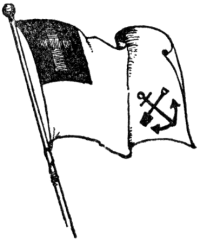
In short, Mr. Denison's compelling personality and enormous capacity for work put others to work, so that in the summer of 1895 9,546 persons were brought together in the old church in five weeks.
So men and women came and went, some of them wrote books and magazine articles about the work with more or less accuracy. Mr. Denison's own poems were more appreciated by those who knew.
The force of it all was irresistible, and so the last trace of opposition in Presbytery and elsewhere disappeared. On November 11, 1895, the sale of the property was called off, and $2,000 a year paid for three years. Ever since Presbyterians and others have been proud of the outpost the united church is maintaining at Market and Henry Streets. It is a happy memory that all of the men who in Presbytery supported sale resolutions became staunch friends of the church.
Mr. Denison was not ordained when first he came to Market Street, but this was done later at Williamstown in the College Chapel. On entering New York Presbytery his installation as regular pastor [89] of the Church of the Sea and Land was effected March 23, 1899.
In 1894 Mrs. Shaw spent considerable money fixing up the lecture room and in 1896 a new roof was put on the church at an expense of $600.
Mr. Denison made a tour of the world, being absent from November, 1900, to October, 1901.
Among the men working under Mr. Denison was Horace Day, a young theological student who gave his life after a brief but intense period of work.
In Mr. Denison's time, too, falls the best work of Mrs. Eliza E. Rockwell. She was indefatigable, beloved of many, none too far gone to merit her attention, nothing too hard to do. She, too, laid down her life as a sacrifice. Even Mr. Denison's book, "Beside the Bowery," insufficiently tells the full measure of her devotion for the thirteen years she was at Sea and Land. Her last message to [90] the trustees was: "I died in harness." It was on March 14, 1908.
One of the men of that day was Edward Dowling. As a tinker he wandered about distributing tracts, speaking the word in truth, and returning during the winter to be factotum in the tower. In that kindly old soul few guessed the old fighter in India. Did he really know the place where priceless treasures were hid beside an old idol?
One of the men in whom united the Sea and Land of the staid old ways and the boundless energy of later days was John Denham. He lived to see the day when the boy in the primary of the school of which he was superintendent for years sat beside him in the session. He was the living embodiment of that perennial spirit in the Church of Christ which ever adjusts itself to new conditions and never loses sight of its main object.
Mr. Denham's strong point was with [91] the older people. It was characteristic to have him read his Bible, quietly take up his hat nearby and pay a visit.
When on February 4, 1910, John Denham went home to the Master whom he had served thru a long life the younger men first felt the burden of things: the senior elder was no more. He had held open the door of the church for many a one and they had entered in.
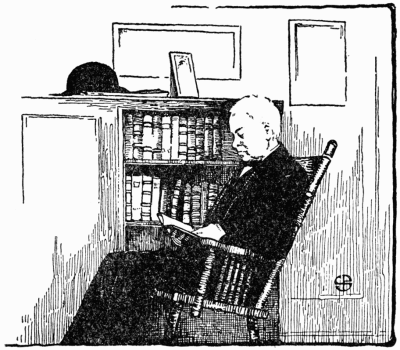
Mr. Denison left the church December 31, 1902, to take up work in Boston. It was a great loss, but as one of the officers said: "What shall we do when Mr. Denison leaves? Why, what we always do at [92] Sea and Land: the best we know how."
Dr. William Adams Brown said: "None know better than the people of Sea and Land how costly the contribution which they have been called to make to the spiritual welfare of a sister city."
It was H. Roswell Bates, who, in the Spring Street Presbyterian church, worked out Mr. Denison's plans, as he had helped to formulate them at the old Market Street church while he was resident there.
Mr. Denison was succeeded by his assistant, William Raymond Jelliffe. They had been close friends, Mr. Jelliffe leaving business and entering the ministry while at Sea and Land. He was ordained June 7, 1900, having been at the church since May, 1893. He left December 31, 1905, to join Mr. Denison in Boston, and later came to the Madison Avenue Presbyterian church as assistant. Mr. Jelliffe did fundamental work with the Young People's Society, that has been a staunch support of the church ever since.
Rev. Orrin Giddings Cocks next headed the church's work. In his time the financial affairs of the church were further strengthened and Mr. Cocks is [94] still an officer of the church which he has served many years.
Following the custom, Mr. Cocks' assistant, Rev. Russell Stanley Gregory, next directed the work, being ordained June 25, 1908, and taking charge at the close of the year. He was at the church ten years.
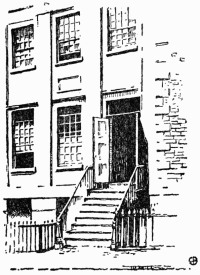
In 1909 the old Consistory Building was torn down. It held precious memories for many, for in spite of its limitations it had in its 66 years given a service that had included about everything one could imagine connected with church work. It had sheltered Sunday school, Lylians, innumerable clubs, a kindergarten, not to speak of the earlier days when prayer-meetings, school, temperance and Young Men's Christian Association meetings [95] exerted an influence that went out far beyond its narrow walls. Even the stoop that had been worn by many feet, some very little, had caused a poet to sing. It all went.
The new building that took its place was splendidly planned by Cady & Gregory. It houses every activity of a modern church. Club rooms for girls, boys and men, gymnasium, showers, kitchens, kindergarten rooms, first-aid rooms, and quarters for the ladies in residence. There is a roof garden where on hot summer evenings services and other gatherings may be held.
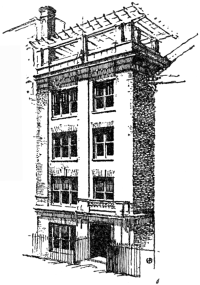
The friends of the church came to its assistance in such munificent manner that not a single contract was made until subscriptions covering it were in the hands of the trustees, and in [96] every instance the actual cash was in the treasury before payments came due. When, on May 3, 1910, the building was opened with appropriate exercises there was a balance on hand more than sufficient for all claims. It cost $43,000.
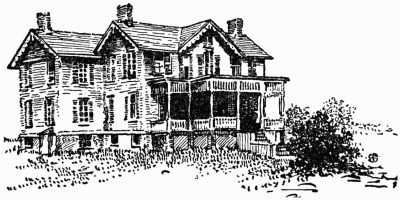
Another important achievement comes in this time. For years the church had been moving about in rented quarters for fresh air work, finally landing on Staten Island for several years. An option had been secured on a house with over eight acres of ground at Oakwood Heights, and after a year's occupancy that proved its availability, it was bought December 30, 1912, and next year some additional land was acquired, including ocean front. The funds collected were sufficient to pay for house and land, as well as a new [97] bungalow and thoro overhauling of the old but substantial house. As in the case of the new Sixty One all moneys needed were in hand before they were required. On every occasion the people of the church themselves have contributed amounts that were sacrifices considering their limited means.
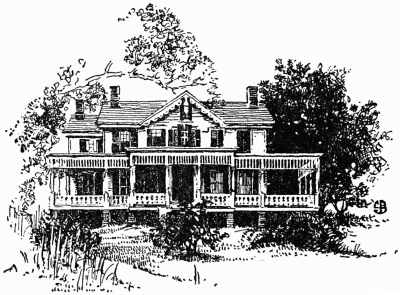
The Fresh Air Fund is entirely separate from the General Fund of the church, and each year the expenses are covered by special subscriptions, in the collection of which Mr. George C. Fraser [98] and Mrs. Stephen Baker have greatly interested themselves for many years. In its early days Miss Helen Gould was one of the good friends of the Fresh Air Fund.
Mr. Gregory left December 1, 1913, to go to East Aurora, N. Y., and was succeeded by Rev. John Ewing Steen, who had been ordained at the church on October 13, 1910.
In 1917 Mr. Steen left suddenly for France in company with Mr. Gregory for Young Men's Christian Association work with the army, Mr. Denison being there also.
On Mr. Steen's leaving a hurry call brought Mr. Alfred D. Moore back once more, under whom the preparations for the church's centennial were taken up in spite of stress of war and inadequate assistance.
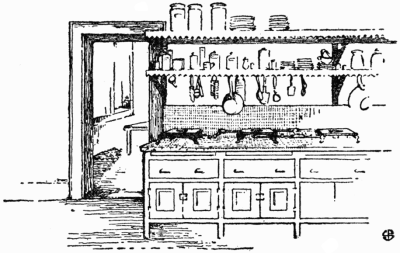
Work among the cosmopolitan population surrounding the church has had various phases during these years.
In Dr. Hopper's time the Scandinavian element among Borella's men predominated, and there was also a small Syrian group at the church, but no services in any language but English were maintained.
Later, home classes in German for the parents of many of the children were kept up for a number of years.
Work among the Jews was carried on for several years and with success, if numbers count. But the methods of the leader were not approved and so the trustees after investigation discontinued [102] the meetings. Dr. John Hall, of the Fifth Avenue church, then most prominent, earnestly supported the man, but in afteryears the correctness of the position taken by Market Street was abundantly proven.
Greek services were supported for quite a while, and since 1914 Russian has been maintained under Mr. Nicholas Motin.
Italian services have been of all these most successful. Rev. Joseph A. Villelli, who was ordained June 23, 1910, has managed these with tact and ability "and the Lord added to the church daily such as should be saved." A separate Sunday school is maintained, but with the idea of gradual amalgamation, a process that is also proving its wisdom along other lines of the church's work.
The advice and active support of men great in business have for many years been at the disposal of the church. From [103] the days of Matthias Bruen, the merchant princes of this great city have been loyal friends, to mention only Hanson K. Corning, father, daughter, grandson, William E. Dodge—for three generations,—and John Crosby Brown and his family.
Along with the sainted Denham should be mentioned Benjamin F. Pinkham, who for twenty years acted as treasurer of the church. He was a quiet man, faithful in every duty, averse to discussion. When the Lord called him home his accounts were in perfect order: a few minutes proved his balance, a space was left for next Sunday's collection in his book.
There were sweet singers in Israel, too, who as precentors and choir leaders have brought out the best there was of tuneful harmony, men like Henry Carpenter, George T. Matthews, Henry Edwards, Allan Robinson, William P. Dunn.
Thru the years some who have cared for the buildings stood out. Charles Greer in the early days, Evan Price, a sturdy Welshman, who died in service, Christian C. Pedersen, who returned to the same post years afterwards. In Mr. Denison's time David J. Ranney served, attaining later to the dignity of city missionary and an autobiography. John A. Ross will be remembered for his omniscience as to people and things about the old church.
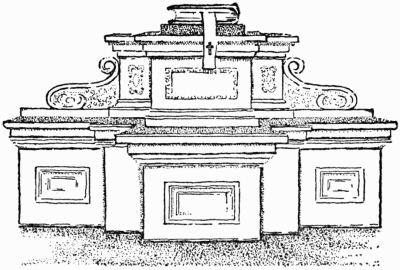
So the old Kirk on Rutgers Farm has stood a hundred years. From its vaulted dome have echoed with no uncertain sound the voices of men like the scholarly Milledoler or the indefatigable Denison, a hundred leaders of men whose words [105] and works have swayed the hearts of men.
Down the broad aisles walked the stately Dutchman, the proud Knickerbocker, the great merchant, the stolid seaman, the busy New Yorker,—to go out and by deeds of victory in times of peace and unflinching loyalty when war's heavy heels trod the land they helped make a great city greater and a mighty nation mightier still.
Never has this been a selfish, self-contained organism, but a living, throbbing influence that went out beyond the shadow of its gray walls, prodigal in giving to others the good things of the gospel that were fostered there. Many a church at home and abroad has cause to bless Market Street for the men and women that she brought up in the nurture and admonition of the Lord.
"We are compassed about with so great a cloud of witnesses, a great multitude, [106] which no man could number." All who have come have felt the spell of the place, for in its dim seclusion still speak the men of old. It is peopled with a long procession of saints and sages, mariners and merchants, scholars and poets, now of the church triumphant: memories that consecrate the souls of men and banish ignoble thoughts. Here is an altar sacred to hosts of men and women, the holy of holies of their noblest aspirations.
"Mark well her bulwarks, that ye may tell it to the generation following." As the years roll on children and children's children will arise and call those blessed whose fidelity thru a century has preserved for them a holy place where "men still renew their youth."
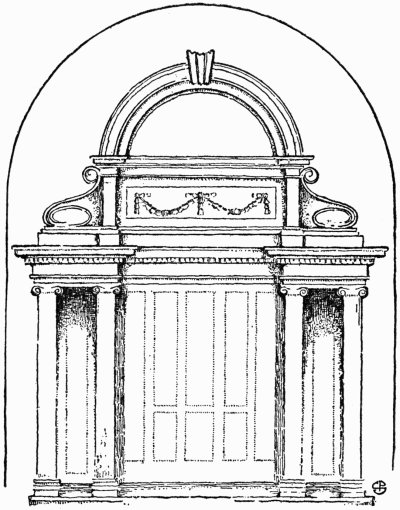
Jesus, Savior, pilot me,
Over life's tempestuous sea;
Unknown waves before me roll,
Hiding rock and treacherous shoal;
Chart and compass come from Thee,
Jesus, Savior, pilot me.
When the apostle's fragile bark
Struggled with the billows dark
On the stormy Galilee,
Thou didst walk upon the sea;
And when they beheld Thy form
Safe they glided thru the storm.
Tho the sea be smooth and bright,
Sparkling with the stars of night,
And my ship's path be ablaze
With the light of halcyon days,
Still I know my need of Thee;
Jesus, Savior, pilot me.
When the darkling heavens frown.
And the wrathful winds come down,
And the fierce waves, tost on high,
Lash themselves against the sky,
Jesus, Savior, pilot me.
Over life's tempestuous sea.
As a mother stills her child
Thou canst hush the ocean wild;
Boisterous waves obey Thy will
When Thou sayest to them "Be still."
Wondrous Sovereign of the sea,
Jesus, Savior, pilot me.
When at last I near the shore,
And the fearful breakers roar,
'Twixt me and the peaceful rest,
Then, while leaning on Thy breast,
May I hear Thee say to me,
"Fear not, I will pilot thee."
The old church long has stood,—
For ages may it stand,
Storehouse of heavenly food
And lighthouse of the land.
Within its sacred walls
What thousands, now asleep,
Where its blest shadow falls
Have bowed to pray and weep!
Old church, with doctrines old
As God's eternal truth,
Within its sacred fold
Men still renew their youth.
Still in its water springs,
Whose streams are never dry,
Hope bathes her drooping wings,
And gathers strength to fly.
Still from its tower of light
The radiant truth is given
To cheer men thru the night
And guide them on to heaven.
Flag of the brave and free!
Flag of our Liberty!
Of thee we sing;
Flag of our father's pride,
With their pure heart's-blood dyed,
When fighting side by side,
Our pledge we bring.
By their pure martyr-blood
Poured on Columbia's sod
For Liberty;
By all their deeds of old,
Their hunger, thirst and cold,
Their battles fierce and bold,
We'll stand by thee!
Thy 'venging stripes shall wave
To guard the homes they gave;
Thy stars shall shine
Upon oppression's night,
To give the patriot light
And make the dark world bright
With hope divine.
We pledge our heart and hand
To bear thee o'er the land
That God made free,—
Till all its vales and hills,
Its rivers and its rills,—
Till the whole nation thrills
With victory!
Fear not, O Ship of State!
Tho pirates with fierce hate
May cross thy sea:—
Fear not; at thy mast head
We've nailed the blue, white, red
Old Flag! Our fathers bled,
And so can we!
We love each tattered rag
Of that old war-rent flag
Of Liberty!
Flag of great Washington!
Flag of brave Anderson!
Flag of each mother's son
Who dares be free!
O God, our banner save!
Make it for ages waves!
God save our flag!
Preserve its honor pure,
Unstained may it endure,
And keep our freedom sure;
God save our flag!
April, 1861.
The Banner.
Soldier, hast thou halted,—
Shrinking from the foe,—
Friendless, beaten, taunted,
Helpless in thy woe?
Rally to the standard!
God shall surely win!
With Him thou shall triumph
Over Death and Sin!
The White.
Hast thou stumbled, fallen?
Have they passed thee by?
In the filth, despairing,
Have they let thee lie?
Up! rise up, and follow
Yonder folds of white!
Thou shalt share their brightness,
Triumph in their light!
The Blue.
Dost thou feel the darkness
Near the gates of death?
Dost thou shrink in terror
At its icy breath?
Lo! the flag is o'er thee
With its field of blue!
It shall guide thee homewards!
Man, thy God is true!
The Red Cross.
Is the conflict bitter?
Art thou faint; at last,
Struggling, panting, straining,
Foul fiends hold thee fast?
Rouse thyself and smite them!
Raise thy standard high!
See, its cross is o'er thee!
Christ, the Lord, is nigh!
The Spade and Anchor.
Christian, hast thou left us—
Left the battle line?
Idling, straggling, wand'ring,
Heedless of the sign?
Hark! the trumpet calls thee!
With us heart and hand
Raise the Spade and Anchor!
Strike for Sea and Land!
Let us stay a while and listen to the voices of the past,
Softly echoing, vaguely lingering, e'er they fade away at last,
Dreaming in a dusky corner of the quaint, blue-panelled pew
While the massive walls of granite shut the hurrying crowds from view,
And the street's loud clang and clatter, screams of rage and cries of pain,
And the endless plodding, thudding, of tired feet in quest of gain
Muffled by a shroud of silence sounds a thousand miles away,
And the past is hovering round us with its ghostly, dim array,
Flitting by in vague procession, up the aisleway, down the hall,
While we lurk here, snugly sheltered, shadowed by the massive wall.
Stately dominies, wig-powdered, all in gowns of silk arrayed;
Fairest dames, slim and high-waisted, clad in flowered, quaint brocade;
[117]Smart young captains, bold as pirates, with their slaves all gaunt and black;
Stout old Dutchmen and their ladies, gowned as in a miller's sack—
How they flit past in the gloaming, thru the huge, high-vaulted hall,
While we lurk here, snugly sheltered, shadowed by the massive wall.
Others come, some wan and haggard, heavy-lined and weary-eyed;
Some with faces flushed and fevered, hearts aflame and hands fast tied.
Others stand with frozen heart-strings, bitter, haughty, desolate;
Some creep past in shame, fresh quivering from some thrust of scorn or hate.
In they throng, all seeking respite from the cruel world's maddening call,
Seeking peace in the dim silence, shadowed by the massive wall.
Other voices, sweet and child-like, linger in the dusky vault,
Cries of babes and tiny maidens, sweet since free from conscious fault,
Here they gather, brown and rosy, golden-haired and crowned with jet,
Glowing cheeks and eyes that dance, where innocence and joy are met.
While without are screams and curses, loathsome vice and drunken brawls,
Here within, God's flowers are sheltered in the shadow of these walls.
Still they stand, a hold unshaken, while the turbid stream of life
Swirls around their bulwarks, brawling, black with sin, with sorrows rife,
While still from the dizzy whirlpool drowning souls creep to the door;
For the House of God, unchanging, stands now and forevermore.
Struggling in life's lonely battle, wounded, faint with many falls
We have found a mighty fortress in the shadow of these walls.
Market Street Dutch Reformed Church | |
| 1820-1835 | William McMurray, D.D. † 1835. |
| 1836-1853 | Isaac Ferris, D.D., † 1873. |
| 1853-1860 | Theodore Ledyard Cuyler, D.D., † 1909. |
| 1861-1862 | Chauncey D. Murray. |
| 1863-1865 | Jacob C. Dutcher. |
Presbyterian Church of the Sea and Land | |
| 1865-1866 | Alexander McGlashan, D.D., † 1867. |
| 1867-1868 | John Lyle, † 1881. |
| 1869-1888 | Edward Hopper, D.D., † 1888. |
| 1888-1889 | Andrew Beattie, Ph.D.; San Anselmo, Cal. |
| 1890-1893 | Alexander W. Sproull, D.D., † 1912. |
| 1895-1902 | John Hopkins Denison; France. |
| 1903-1905 | William Raymond Jelliffe; New York. |
| 1906-1908 | Orrin Giddings Cocks; New York. |
| 1909-1913 | Russell Stanley Gregory; East Aurora, N. Y. |
| 1914-1917 | John Ewing Steen; France. |
| 1910 | Joseph Anthony Villelli. |
| 1917 | Alfred D. Moore. |
| 1919 | Russell J. Clinchy. |
"It has been the high purpose of this church to train a type of minister for whom the hard places of life are places of honor, and who have been going out from there spreading the contagion of that idea in the ministry of to-day, making this church a great training school for a new order of ministers."—George Alexander, D.D.
Printed in the United States of America.
End of Project Gutenberg's The Kirk on Rutgers Farm, by Frederick Brückbauer
*** END OF THIS PROJECT GUTENBERG EBOOK THE KIRK ON RUTGERS FARM ***
***** This file should be named 25293-h.htm or 25293-h.zip *****
This and all associated files of various formats will be found in:
http://www.gutenberg.org/2/5/2/9/25293/
Produced by David Garcia and The Online Distributed
Proofreading Team at http://www.pgdp.net
Updated editions will replace the previous one--the old editions
will be renamed.
Creating the works from public domain print editions means that no
one owns a United States copyright in these works, so the Foundation
(and you!) can copy and distribute it in the United States without
permission and without paying copyright royalties. Special rules,
set forth in the General Terms of Use part of this license, apply to
copying and distributing Project Gutenberg-tm electronic works to
protect the PROJECT GUTENBERG-tm concept and trademark. Project
Gutenberg is a registered trademark, and may not be used if you
charge for the eBooks, unless you receive specific permission. If you
do not charge anything for copies of this eBook, complying with the
rules is very easy. You may use this eBook for nearly any purpose
such as creation of derivative works, reports, performances and
research. They may be modified and printed and given away--you may do
practically ANYTHING with public domain eBooks. Redistribution is
subject to the trademark license, especially commercial
redistribution.
*** START: FULL LICENSE ***
THE FULL PROJECT GUTENBERG LICENSE
PLEASE READ THIS BEFORE YOU DISTRIBUTE OR USE THIS WORK
To protect the Project Gutenberg-tm mission of promoting the free
distribution of electronic works, by using or distributing this work
(or any other work associated in any way with the phrase "Project
Gutenberg"), you agree to comply with all the terms of the Full Project
Gutenberg-tm License (available with this file or online at
http://gutenberg.org/license).
Section 1. General Terms of Use and Redistributing Project Gutenberg-tm
electronic works
1.A. By reading or using any part of this Project Gutenberg-tm
electronic work, you indicate that you have read, understand, agree to
and accept all the terms of this license and intellectual property
(trademark/copyright) agreement. If you do not agree to abide by all
the terms of this agreement, you must cease using and return or destroy
all copies of Project Gutenberg-tm electronic works in your possession.
If you paid a fee for obtaining a copy of or access to a Project
Gutenberg-tm electronic work and you do not agree to be bound by the
terms of this agreement, you may obtain a refund from the person or
entity to whom you paid the fee as set forth in paragraph 1.E.8.
1.B. "Project Gutenberg" is a registered trademark. It may only be
used on or associated in any way with an electronic work by people who
agree to be bound by the terms of this agreement. There are a few
things that you can do with most Project Gutenberg-tm electronic works
even without complying with the full terms of this agreement. See
paragraph 1.C below. There are a lot of things you can do with Project
Gutenberg-tm electronic works if you follow the terms of this agreement
and help preserve free future access to Project Gutenberg-tm electronic
works. See paragraph 1.E below.
1.C. The Project Gutenberg Literary Archive Foundation ("the Foundation"
or PGLAF), owns a compilation copyright in the collection of Project
Gutenberg-tm electronic works. Nearly all the individual works in the
collection are in the public domain in the United States. If an
individual work is in the public domain in the United States and you are
located in the United States, we do not claim a right to prevent you from
copying, distributing, performing, displaying or creating derivative
works based on the work as long as all references to Project Gutenberg
are removed. Of course, we hope that you will support the Project
Gutenberg-tm mission of promoting free access to electronic works by
freely sharing Project Gutenberg-tm works in compliance with the terms of
this agreement for keeping the Project Gutenberg-tm name associated with
the work. You can easily comply with the terms of this agreement by
keeping this work in the same format with its attached full Project
Gutenberg-tm License when you share it without charge with others.
1.D. The copyright laws of the place where you are located also govern
what you can do with this work. Copyright laws in most countries are in
a constant state of change. If you are outside the United States, check
the laws of your country in addition to the terms of this agreement
before downloading, copying, displaying, performing, distributing or
creating derivative works based on this work or any other Project
Gutenberg-tm work. The Foundation makes no representations concerning
the copyright status of any work in any country outside the United
States.
1.E. Unless you have removed all references to Project Gutenberg:
1.E.1. The following sentence, with active links to, or other immediate
access to, the full Project Gutenberg-tm License must appear prominently
whenever any copy of a Project Gutenberg-tm work (any work on which the
phrase "Project Gutenberg" appears, or with which the phrase "Project
Gutenberg" is associated) is accessed, displayed, performed, viewed,
copied or distributed:
This eBook is for the use of anyone anywhere at no cost and with
almost no restrictions whatsoever. You may copy it, give it away or
re-use it under the terms of the Project Gutenberg License included
with this eBook or online at www.gutenberg.org
1.E.2. If an individual Project Gutenberg-tm electronic work is derived
from the public domain (does not contain a notice indicating that it is
posted with permission of the copyright holder), the work can be copied
and distributed to anyone in the United States without paying any fees
or charges. If you are redistributing or providing access to a work
with the phrase "Project Gutenberg" associated with or appearing on the
work, you must comply either with the requirements of paragraphs 1.E.1
through 1.E.7 or obtain permission for the use of the work and the
Project Gutenberg-tm trademark as set forth in paragraphs 1.E.8 or
1.E.9.
1.E.3. If an individual Project Gutenberg-tm electronic work is posted
with the permission of the copyright holder, your use and distribution
must comply with both paragraphs 1.E.1 through 1.E.7 and any additional
terms imposed by the copyright holder. Additional terms will be linked
to the Project Gutenberg-tm License for all works posted with the
permission of the copyright holder found at the beginning of this work.
1.E.4. Do not unlink or detach or remove the full Project Gutenberg-tm
License terms from this work, or any files containing a part of this
work or any other work associated with Project Gutenberg-tm.
1.E.5. Do not copy, display, perform, distribute or redistribute this
electronic work, or any part of this electronic work, without
prominently displaying the sentence set forth in paragraph 1.E.1 with
active links or immediate access to the full terms of the Project
Gutenberg-tm License.
1.E.6. You may convert to and distribute this work in any binary,
compressed, marked up, nonproprietary or proprietary form, including any
word processing or hypertext form. However, if you provide access to or
distribute copies of a Project Gutenberg-tm work in a format other than
"Plain Vanilla ASCII" or other format used in the official version
posted on the official Project Gutenberg-tm web site (www.gutenberg.org),
you must, at no additional cost, fee or expense to the user, provide a
copy, a means of exporting a copy, or a means of obtaining a copy upon
request, of the work in its original "Plain Vanilla ASCII" or other
form. Any alternate format must include the full Project Gutenberg-tm
License as specified in paragraph 1.E.1.
1.E.7. Do not charge a fee for access to, viewing, displaying,
performing, copying or distributing any Project Gutenberg-tm works
unless you comply with paragraph 1.E.8 or 1.E.9.
1.E.8. You may charge a reasonable fee for copies of or providing
access to or distributing Project Gutenberg-tm electronic works provided
that
- You pay a royalty fee of 20% of the gross profits you derive from
the use of Project Gutenberg-tm works calculated using the method
you already use to calculate your applicable taxes. The fee is
owed to the owner of the Project Gutenberg-tm trademark, but he
has agreed to donate royalties under this paragraph to the
Project Gutenberg Literary Archive Foundation. Royalty payments
must be paid within 60 days following each date on which you
prepare (or are legally required to prepare) your periodic tax
returns. Royalty payments should be clearly marked as such and
sent to the Project Gutenberg Literary Archive Foundation at the
address specified in Section 4, "Information about donations to
the Project Gutenberg Literary Archive Foundation."
- You provide a full refund of any money paid by a user who notifies
you in writing (or by e-mail) within 30 days of receipt that s/he
does not agree to the terms of the full Project Gutenberg-tm
License. You must require such a user to return or
destroy all copies of the works possessed in a physical medium
and discontinue all use of and all access to other copies of
Project Gutenberg-tm works.
- You provide, in accordance with paragraph 1.F.3, a full refund of any
money paid for a work or a replacement copy, if a defect in the
electronic work is discovered and reported to you within 90 days
of receipt of the work.
- You comply with all other terms of this agreement for free
distribution of Project Gutenberg-tm works.
1.E.9. If you wish to charge a fee or distribute a Project Gutenberg-tm
electronic work or group of works on different terms than are set
forth in this agreement, you must obtain permission in writing from
both the Project Gutenberg Literary Archive Foundation and Michael
Hart, the owner of the Project Gutenberg-tm trademark. Contact the
Foundation as set forth in Section 3 below.
1.F.
1.F.1. Project Gutenberg volunteers and employees expend considerable
effort to identify, do copyright research on, transcribe and proofread
public domain works in creating the Project Gutenberg-tm
collection. Despite these efforts, Project Gutenberg-tm electronic
works, and the medium on which they may be stored, may contain
"Defects," such as, but not limited to, incomplete, inaccurate or
corrupt data, transcription errors, a copyright or other intellectual
property infringement, a defective or damaged disk or other medium, a
computer virus, or computer codes that damage or cannot be read by
your equipment.
1.F.2. LIMITED WARRANTY, DISCLAIMER OF DAMAGES - Except for the "Right
of Replacement or Refund" described in paragraph 1.F.3, the Project
Gutenberg Literary Archive Foundation, the owner of the Project
Gutenberg-tm trademark, and any other party distributing a Project
Gutenberg-tm electronic work under this agreement, disclaim all
liability to you for damages, costs and expenses, including legal
fees. YOU AGREE THAT YOU HAVE NO REMEDIES FOR NEGLIGENCE, STRICT
LIABILITY, BREACH OF WARRANTY OR BREACH OF CONTRACT EXCEPT THOSE
PROVIDED IN PARAGRAPH F3. YOU AGREE THAT THE FOUNDATION, THE
TRADEMARK OWNER, AND ANY DISTRIBUTOR UNDER THIS AGREEMENT WILL NOT BE
LIABLE TO YOU FOR ACTUAL, DIRECT, INDIRECT, CONSEQUENTIAL, PUNITIVE OR
INCIDENTAL DAMAGES EVEN IF YOU GIVE NOTICE OF THE POSSIBILITY OF SUCH
DAMAGE.
1.F.3. LIMITED RIGHT OF REPLACEMENT OR REFUND - If you discover a
defect in this electronic work within 90 days of receiving it, you can
receive a refund of the money (if any) you paid for it by sending a
written explanation to the person you received the work from. If you
received the work on a physical medium, you must return the medium with
your written explanation. The person or entity that provided you with
the defective work may elect to provide a replacement copy in lieu of a
refund. If you received the work electronically, the person or entity
providing it to you may choose to give you a second opportunity to
receive the work electronically in lieu of a refund. If the second copy
is also defective, you may demand a refund in writing without further
opportunities to fix the problem.
1.F.4. Except for the limited right of replacement or refund set forth
in paragraph 1.F.3, this work is provided to you 'AS-IS' WITH NO OTHER
WARRANTIES OF ANY KIND, EXPRESS OR IMPLIED, INCLUDING BUT NOT LIMITED TO
WARRANTIES OF MERCHANTIBILITY OR FITNESS FOR ANY PURPOSE.
1.F.5. Some states do not allow disclaimers of certain implied
warranties or the exclusion or limitation of certain types of damages.
If any disclaimer or limitation set forth in this agreement violates the
law of the state applicable to this agreement, the agreement shall be
interpreted to make the maximum disclaimer or limitation permitted by
the applicable state law. The invalidity or unenforceability of any
provision of this agreement shall not void the remaining provisions.
1.F.6. INDEMNITY - You agree to indemnify and hold the Foundation, the
trademark owner, any agent or employee of the Foundation, anyone
providing copies of Project Gutenberg-tm electronic works in accordance
with this agreement, and any volunteers associated with the production,
promotion and distribution of Project Gutenberg-tm electronic works,
harmless from all liability, costs and expenses, including legal fees,
that arise directly or indirectly from any of the following which you do
or cause to occur: (a) distribution of this or any Project Gutenberg-tm
work, (b) alteration, modification, or additions or deletions to any
Project Gutenberg-tm work, and (c) any Defect you cause.
Section 2. Information about the Mission of Project Gutenberg-tm
Project Gutenberg-tm is synonymous with the free distribution of
electronic works in formats readable by the widest variety of computers
including obsolete, old, middle-aged and new computers. It exists
because of the efforts of hundreds of volunteers and donations from
people in all walks of life.
Volunteers and financial support to provide volunteers with the
assistance they need, is critical to reaching Project Gutenberg-tm's
goals and ensuring that the Project Gutenberg-tm collection will
remain freely available for generations to come. In 2001, the Project
Gutenberg Literary Archive Foundation was created to provide a secure
and permanent future for Project Gutenberg-tm and future generations.
To learn more about the Project Gutenberg Literary Archive Foundation
and how your efforts and donations can help, see Sections 3 and 4
and the Foundation web page at http://www.pglaf.org.
Section 3. Information about the Project Gutenberg Literary Archive
Foundation
The Project Gutenberg Literary Archive Foundation is a non profit
501(c)(3) educational corporation organized under the laws of the
state of Mississippi and granted tax exempt status by the Internal
Revenue Service. The Foundation's EIN or federal tax identification
number is 64-6221541. Its 501(c)(3) letter is posted at
http://pglaf.org/fundraising. Contributions to the Project Gutenberg
Literary Archive Foundation are tax deductible to the full extent
permitted by U.S. federal laws and your state's laws.
The Foundation's principal office is located at 4557 Melan Dr. S.
Fairbanks, AK, 99712., but its volunteers and employees are scattered
throughout numerous locations. Its business office is located at
809 North 1500 West, Salt Lake City, UT 84116, (801) 596-1887, email
business@pglaf.org. Email contact links and up to date contact
information can be found at the Foundation's web site and official
page at http://pglaf.org
For additional contact information:
Dr. Gregory B. Newby
Chief Executive and Director
gbnewby@pglaf.org
Section 4. Information about Donations to the Project Gutenberg
Literary Archive Foundation
Project Gutenberg-tm depends upon and cannot survive without wide
spread public support and donations to carry out its mission of
increasing the number of public domain and licensed works that can be
freely distributed in machine readable form accessible by the widest
array of equipment including outdated equipment. Many small donations
($1 to $5,000) are particularly important to maintaining tax exempt
status with the IRS.
The Foundation is committed to complying with the laws regulating
charities and charitable donations in all 50 states of the United
States. Compliance requirements are not uniform and it takes a
considerable effort, much paperwork and many fees to meet and keep up
with these requirements. We do not solicit donations in locations
where we have not received written confirmation of compliance. To
SEND DONATIONS or determine the status of compliance for any
particular state visit http://pglaf.org
While we cannot and do not solicit contributions from states where we
have not met the solicitation requirements, we know of no prohibition
against accepting unsolicited donations from donors in such states who
approach us with offers to donate.
International donations are gratefully accepted, but we cannot make
any statements concerning tax treatment of donations received from
outside the United States. U.S. laws alone swamp our small staff.
Please check the Project Gutenberg Web pages for current donation
methods and addresses. Donations are accepted in a number of other
ways including checks, online payments and credit card donations.
To donate, please visit: http://pglaf.org/donate
Section 5. General Information About Project Gutenberg-tm electronic
works.
Professor Michael S. Hart is the originator of the Project Gutenberg-tm
concept of a library of electronic works that could be freely shared
with anyone. For thirty years, he produced and distributed Project
Gutenberg-tm eBooks with only a loose network of volunteer support.
Project Gutenberg-tm eBooks are often created from several printed
editions, all of which are confirmed as Public Domain in the U.S.
unless a copyright notice is included. Thus, we do not necessarily
keep eBooks in compliance with any particular paper edition.
Most people start at our Web site which has the main PG search facility:
http://www.gutenberg.org
This Web site includes information about Project Gutenberg-tm,
including how to make donations to the Project Gutenberg Literary
Archive Foundation, how to help produce our new eBooks, and how to
subscribe to our email newsletter to hear about new eBooks.